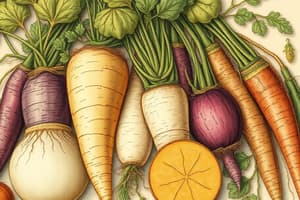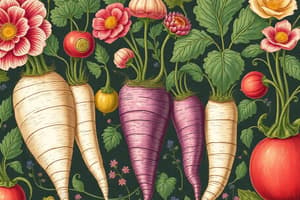Podcast
Questions and Answers
Which of the following root vegetables is known for its high inulin content and is often recommended for individuals managing diabetes?
Which of the following root vegetables is known for its high inulin content and is often recommended for individuals managing diabetes?
- Cassava
- Beet root
- Jicama (correct)
- Sweet potato
A patient presents with hemolytic anemia after consuming a certain type of bean. Which of the following beans is most likely the cause of this condition, known as favism?
A patient presents with hemolytic anemia after consuming a certain type of bean. Which of the following beans is most likely the cause of this condition, known as favism?
- Sugar snap peas
- String bean
- Peanuts
- Fava bean (correct)
Which of these plants contains cyanogenic glycosides, requiring it to be fully cooked before consumption to avoid toxicity?
Which of these plants contains cyanogenic glycosides, requiring it to be fully cooked before consumption to avoid toxicity?
- Taro
- Sunflower Chokes
- Ginger
- Cassava (correct)
Which of the following vegetables belongs to the Amaranthaceae family?
Which of the following vegetables belongs to the Amaranthaceae family?
Which of the following pairs of plants are both members of the Brassicaceae (Mustard) family?
Which of the following pairs of plants are both members of the Brassicaceae (Mustard) family?
What primary characteristic distinguishes a stem tuber from a root tuber?
What primary characteristic distinguishes a stem tuber from a root tuber?
Certain edible bulbs, such as red onions, are known to contain quercetin. What health benefit is primarily associated with this compound?
Certain edible bulbs, such as red onions, are known to contain quercetin. What health benefit is primarily associated with this compound?
Why is it suggested that turnip greens may help 'detox the liver'?
Why is it suggested that turnip greens may help 'detox the liver'?
Which of the following best explains why asparagus is considered a diuretic?
Which of the following best explains why asparagus is considered a diuretic?
What is the primary reason for handling cassava with gloves and ensuring it’s fully cooked before consumption?
What is the primary reason for handling cassava with gloves and ensuring it’s fully cooked before consumption?
Which of the following cooking practices would best preserve the vibrant color of green leafy vegetables?
Which of the following cooking practices would best preserve the vibrant color of green leafy vegetables?
A patient with diabetes is looking to incorporate more vegetables into their diet to help manage blood sugar levels. Which of the following would be most beneficial?
A patient with diabetes is looking to incorporate more vegetables into their diet to help manage blood sugar levels. Which of the following would be most beneficial?
Which of the following legumes does NOT require soaking before cooking?
Which of the following legumes does NOT require soaking before cooking?
A chef wants to maximize the absorption of carotenoids from a vegetable dish. Which of the following preparation techniques would be most effective?
A chef wants to maximize the absorption of carotenoids from a vegetable dish. Which of the following preparation techniques would be most effective?
Which vegetable is categorized under the Solanaceae (Nightshade) family?
Which vegetable is categorized under the Solanaceae (Nightshade) family?
If a recipe calls for a vegetable known for its diuretic properties and its membership in the Cucurbitaceae family, which of the following would be the MOST suitable ingredient?
If a recipe calls for a vegetable known for its diuretic properties and its membership in the Cucurbitaceae family, which of the following would be the MOST suitable ingredient?
A food scientist is trying to minimize an 'off flavor' in a soybean-based product. Which of the following enzymes should they target to reduce this flavor?
A food scientist is trying to minimize an 'off flavor' in a soybean-based product. Which of the following enzymes should they target to reduce this flavor?
Which of the following vegetables is associated with glucosinolates, compounds known for their anti-cancer properties?
Which of the following vegetables is associated with glucosinolates, compounds known for their anti-cancer properties?
Which of the following best explains why red cabbage turns cooking water a deep red color?
Which of the following best explains why red cabbage turns cooking water a deep red color?
To mitigate potential digestive discomfort (gas) associated with consuming legumes, which of the following culinary practices is MOST appropriate?
To mitigate potential digestive discomfort (gas) associated with consuming legumes, which of the following culinary practices is MOST appropriate?
Flashcards
Bulb
Bulb
Modified underground stem for storage (monocot).
Root Tuber
Root Tuber
Modified root that stores nutrients.
Stem Tuber
Stem Tuber
Swollen underground stem that stores nutrients.
Hypocotyl Taproot
Hypocotyl Taproot
Signup and view all the flashcards
Rhizome
Rhizome
Signup and view all the flashcards
Brassicaceae Family
Brassicaceae Family
Signup and view all the flashcards
Apiaceae Family
Apiaceae Family
Signup and view all the flashcards
Amaryllidaceae Family
Amaryllidaceae Family
Signup and view all the flashcards
Anthocyanin
Anthocyanin
Signup and view all the flashcards
Corm
Corm
Signup and view all the flashcards
Amaranthaceae
Amaranthaceae
Signup and view all the flashcards
Bitter Melon
Bitter Melon
Signup and view all the flashcards
Mustard Greens
Mustard Greens
Signup and view all the flashcards
Chayote Squash
Chayote Squash
Signup and view all the flashcards
Tomato
Tomato
Signup and view all the flashcards
Celeriac
Celeriac
Signup and view all the flashcards
Cruciferous Vegetables
Cruciferous Vegetables
Signup and view all the flashcards
Apiaceae
Apiaceae
Signup and view all the flashcards
Cucurbitaceae
Cucurbitaceae
Signup and view all the flashcards
Amaryllidaceae
Amaryllidaceae
Signup and view all the flashcards
Study Notes
- Daikon is a winter radish from Asia and falls under the Brassicaceae family.
- Parsnip is similar to a paler, sweeter carrot.
- Turnip greens detoxify the liver and are high in calcium.
- Jicama has a high content of inulin, which is prebiotic and has a low glycemic index, making it suitable for diabetics.
- Ginger can reduce inflammation and help fight infections.
- Garlic contains polyphenols, which have anti-inflammatory properties
- Red onions contain the flavonoid quercetin and sulfur compounds, providing anti-inflammatory benefits.
- Shallots contain the flavonoid quercetin and sulfur compounds, providing anti-inflammatory benefits.
- Leeks contain polyphenols such as kaempferol and sulfur compounds, providing anti-inflammatory effects.
- White potatoes are stem tubers used for starch storage.
- Sweet potatoes are root tubers and contain carotenoids.
- Beet roots contain betalains.
- Fava beans can cause hemolytic anemia (favism) due to their alkaloid content.
- Peanuts are legumes where the edible parts are the seeds, containing approximately 50% oil.
- Sugar snap peas are one of the oldest cultivated foods.
- Sunflower chokes contain high levels of inulin, which are good for people with diabetes.
- Cassava contains cyanogenic glycosides, making it toxic unless fully cooked; gloves should be worn when handling.
- Purple potatoes are root tubers and contain anthocyanin.
- Rutabagas are root vegetables containing carotenoids and are rougher than turnips.
- Taro is toxic due to calcium oxalate.
- Sweet white potatoes are root tubers that contain carotenoids.
- Watercress is anti-inflammatory and has a bitter, peppery taste.
- Asparagus is a diuretic with edible tender shoot tips.
- Tomatillos are used in salsa verdes.
- Collard greens are high in calcium.
- Artichokes are flower buds.
- Beets and their greens are high in fiber and iron.
- Fennel tastes like a sweeter onion without the sharp bite.
- Arugula is rich in folate, which is important for cell growth.
- Aloe contains vitamins C, E, and B, benefiting skin and immunity, and acts as a laxative.
- Broccoli raab promotes eye health.
- Swiss chard can have colorful stems and is rich in fiber and magnesium.
- Amaranth is high in protein (lysine), fiber, iron, magnesium, calcium, and is gluten-free.
- Bitter melon may help lower blood sugar levels.
- Mustard greens are high in fiber and folate.
- Chayote squash is a diuretic, which may help support kidney health.
- Tomatoes contain lycopene, an antioxidant beneficial for heart health, and may help in lowering cholesterol.
- Celeriac contains vitamin B6 and acts as a diuretic.
- Young, tender luffa squash is edible, and the mature luffa is used for natural sponges.
- Endive contains inulin.
- Dandelion greens are bitter and may help with liver detoxification.
- Kohlrabi is rich in glucosinolates, offering anti-cancer properties.
- Bottle gourds are low in calories and high in dietary fiber.
- Red cabbage contains anthocyanin.
- Kale is bitter, may help with liver detox., and high in calcium.
- Okra is good for blood sugar regulation.
- Bok choy contains dietary fiber and detoxifies the liver.
- Bell peppers can have carotenoids or chloroplasts, based on color.
- Bell peppers contain flavonoids.
- Pigeon peas, originate from India and are cooked like lentils.
- Chickpeas are the basis of gram flour and are high in protein.
- Black-eyed peas originate from Africa and are part of New Year's traditions.
- Urad dhal ladoos may be given to new mothers because of its high protein.
- Soybeans can have an off flavor due to the enzyme lipoxygenase.
- Split peas are commonly used in split pea soup.
- Yam beans are rich in proteins and carbohydrates and are similar to soybeans.
- Tamarind is a brown, sticky pulp with a sweet and sour taste, used in chutneys and sauces.
- Lentils are lens-shaped seeds, considered one of the most ancient plants.
- Lentils have the third-highest protein content after soybean and hemp.
- Beans include kidney, navy, pinto, black, green, and wax beans.
- Lima beans are from Lima, Peru.
- Fenugreek originates from the Mediterranean and has a bitter taste.
Vegetable families
- Key cruciferous veggies include broccoli, kale, mustard greens, turnip, radish, rutabaga, watercress, collard greens, arugula, broccoli raab, kohlrabi, red cabbage, and bok choy.
- Solanaceae: Includes tomato, tomatillo, eggplant, potato, and bell pepper.
- Apiaceae: Includes carrot, parsnip, celery, celeriac, parsley, and fennel.
- Cucurbitaceae: Includes cucumber, melons (like bitter melon), squash (like chayote and luffa), and bottle gourd.
- Amaranthaceae: Includes beet root and greens, swiss chard, amaranth, and spinach.
- Amaryllidaceae: Includes garlic, red onion, shallot, and leek.
- Asteraceae: Includes dandelion greens, artichoke, endive, and sunchoke.
- Fabaceae: Jicama, broad beans, snap peas, lentils, soybeans and peanuts are included in this legume family.
Cooking Tips
- Blanching is best for color preservation in vegetables.
- Flavonoids produce red/blue-purple colors and are water-soluble, so they may be lost when cooking in water.
- Carotenoids produce yellow-orange colors and are fat-soluble, needing fat (oil) for absorption.
- Leafy greens should not be cooked with a lid on or with an acid, as oxalate crystals can turn into dull-colored pheophytin.
- Acids harden pectin in legumes, so they should be added after cooking.
- Dried legumes, except mung beans, lentils, and split peas, must be soaked before cooking.
- Too much alkaline substance (baking powder) can destroy thiamin and impart a soapy or salty flavor.
- Add a carminative (ginger, cardamom, etc.) or probiotic to legumes when cooking to prevent gas and aid digestion.
Studying That Suits You
Use AI to generate personalized quizzes and flashcards to suit your learning preferences.



